HORNER SYNDROME: CERVICAL SYMPATHETIC/OCULOSYMPATHETIC NEUROPATHY
KEY POINTS
- Computed tomography including computed tomographic angiography is the primary tool for looking for a structural cause for a Horner syndrome that is likely to involving the skull base or more distal course of the cervical sympathetics.
- Magnetic resonance imaging may be used if the pathology likely localizes to the brain stem, spinal cord, or meninges or the upper thoracic spinal subarachnoid space in question.
- Magnetic resonance imaging and magnetic resonance angiography cannot be trusted to confidently exclude all conditions that may lead to Horner syndrome, especially those of the skull base and vertebral artery dissections.
- Diagnostic imaging, even performed optimally, may not find a reason for Horner neuropathies; this may require further surveillance plans that may include imaging.
INTRODUCTION
Clinical Presentation
The cervical sympathetic plexus and the vagus, glossopharyngeal, spinal accessory, and hypoglossal nerves may be considered as a unit as well as individually. Although one of these may dominate the clinical presentation, more than one will often be involved following careful clinical testing. The cervical sympathetics are more often than not affected as an isolated finding producing some variant of Horner syndrome, of which its complete expression will include ptosis, miosis, and anhydrosis. This tendency for the cervical sympathetics to be affected as an isolated finding is in part due to the deficit often being caused by devascularization related to a carotid dissection or brain stem thromboembolic disease secondary to vertebral artery dissection or other posterior circulation vaso-occlusive etiologies. The cervical sympathetics may also be involved coincidentally with a brachial plexopathy or any of cranial nerves (CNs) IX through XII.
When more than one nerve is affected, and possibly associated with other symptoms or neurologic deficits, localization is often much easier and a very “directed” and concise imaging evaluation is possible. However, some situations require a comprehensive imaging study of nearly the entire head and neck regions and sometimes the upper chest. For instance, CN X and cervical sympathetics have a long course between the brain and skull and the chest, and CNs IX and X have important pathways of referred pain. Such considerations and combinations of clinical findings may affect the imaging approach to identify a source of a patient’s presenting complaints and deficits. This clinically responsive tactical approach should become apparent later in this chapter and in Chapters 137 through 140.
Lesions outside the expected course of the nerves or involving end organs will sometimes be the source of symptoms—for example, a tongue base carcinoma causing ear pain that is referred along the glossopharyngeal nerve. It is critical to understand all of the neurologic deficits and complaints that might arise from these nerves to enable effective imaging and interpretation of the images. In this light, sometimes anisocoria is taken for a sign of a partial Horner syndrome. If this is the only physical finding suggestive of oculosympathetic pathway disruption, it is extremely unlikely that imaging will produce evidence of a structural lesion of the cervical sympathetics. Horner syndrome is sometimes associated with the acute onset of ipsilateral headache, otalgia, and/or neck pain, in which case it is almost certainly due to a carotid or vertebral artery dissection.
Horner syndrome is often associated with structural pathology; however, a structural cause may not be found since the signs and symptoms of Horner syndrome are caused by a significant number of medications. Imaging is an important part of the workup and must be focused properly by the clinical data. The cause will turn out to be neoplastic in many cases when a nonvascular etiology is established by imaging.
Common general clinical presentations that may involve the various segments of the cervical sympathetic plexus are as follows:
 Central Horner syndrome will often have obvious accompanying somatosensory and/or motor symptoms and can be caused by ischemia, demyelinating disease, syringohydromyelia, and glioma, to name a few. Magnetic resonance (MR) is the obvious imaging choice in these cases.
Central Horner syndrome will often have obvious accompanying somatosensory and/or motor symptoms and can be caused by ischemia, demyelinating disease, syringohydromyelia, and glioma, to name a few. Magnetic resonance (MR) is the obvious imaging choice in these cases.
 Acute-onset Horner syndrome with headache, otalgia, or neck pain is virtually always secondary to a carotid and occasionally a vertebral artery dissection.
Acute-onset Horner syndrome with headache, otalgia, or neck pain is virtually always secondary to a carotid and occasionally a vertebral artery dissection.
 Horner syndrome and brachial plexopathy will be due to a thoracic inlet lesion.
Horner syndrome and brachial plexopathy will be due to a thoracic inlet lesion.
 Horner syndrome and hoarseness may be due to a lesion anywhere from the carotid canal to the thoracic inlet.
Horner syndrome and hoarseness may be due to a lesion anywhere from the carotid canal to the thoracic inlet.
Oculosympathetic and jugular fossa syndromes
 Several French eponyms have been applied to clinical findings when three, four, or five (if the sympathetics are included) members of this group of nerves are involved. These include Vernet syndrome (IX–XI), Collet-Sicard syndrome (IX–XII), Villaret syndrome (IX–XII and the sympathetic plexus).
Several French eponyms have been applied to clinical findings when three, four, or five (if the sympathetics are included) members of this group of nerves are involved. These include Vernet syndrome (IX–XI), Collet-Sicard syndrome (IX–XII), Villaret syndrome (IX–XII and the sympathetic plexus).
 French eponyms are mentioned because they are occasionally presented as an indication for the imaging procedure; however, it is more useful to describe the specific nerves at risk. If three of the five are involved, the lesion will be at or near the skull base. The lesion will usually be somewhere between the medullary cistern–jugular fossa region and the posterior belly of the digastric muscle. If just two are involved, the lesion could lie in this relatively confined space in and around the skull base, but a more comprehensive imaging evaluation often becomes necessary.
French eponyms are mentioned because they are occasionally presented as an indication for the imaging procedure; however, it is more useful to describe the specific nerves at risk. If three of the five are involved, the lesion will be at or near the skull base. The lesion will usually be somewhere between the medullary cistern–jugular fossa region and the posterior belly of the digastric muscle. If just two are involved, the lesion could lie in this relatively confined space in and around the skull base, but a more comprehensive imaging evaluation often becomes necessary.
Referred otalgia
 Referred otalgia and vocal cord paresis may be associated with Horner syndrome. The details of those two possibly associated conditions are discussed in Chapters 137 and 138. If the vocal cord paresis is accompanied by a deficit in one or more of CNs IX, XI, or XII, then the posterior fossa, skull base, and deep neck spaces down to the posterior belly of the digastric muscle must be covered. If the only other deficit is of the cervical sympathetics (Horner syndrome), then the lesion may lie between the skull base and thoracic inlet and other accompanying symptoms such as a brachial plexopathy helps direct the examination.
Referred otalgia and vocal cord paresis may be associated with Horner syndrome. The details of those two possibly associated conditions are discussed in Chapters 137 and 138. If the vocal cord paresis is accompanied by a deficit in one or more of CNs IX, XI, or XII, then the posterior fossa, skull base, and deep neck spaces down to the posterior belly of the digastric muscle must be covered. If the only other deficit is of the cervical sympathetics (Horner syndrome), then the lesion may lie between the skull base and thoracic inlet and other accompanying symptoms such as a brachial plexopathy helps direct the examination.
APPLIED ANATOMY
The pathways for the pre- and postganglionic fibers mediating the oculosympathetic responses that result in Horner syndrome run from the hypothalamus to the T3 level of the spinal cord and back to the eye and face via the carotid. Along the way, there are the inferior, middle, and superior cervical ganglia. First-order neurons originating from the hypothalamus synapse in the pons or spinal cord and exit at C8 T1-2 as second-order preganglionic neurons. These follow a course over the apex of the lung and ascend to synapse in the superior cervical ganglion. They exit as third-order postganglionic neurons to form sympathetic plexuses around the internal and external carotid artery. Lesions arising below T1 may spare the eye.
The preganglionic sympathetic plexus ascends medial to the common carotid artery from the thoracic inlet while giving off essentially no branches in the infrahyoid neck (or at least below the carotid bifurcations) but getting its blood supply from the carotid artery.
The inferior cervical ganglion lies at about the level of the vertebral artery takeoff from the subclavian situated medial and slightly inferior to those vessels (Fig. 141.1A,B,H). A good posterior marker is the lateral aspect of the longus colli and longus capitus muscles, even though those muscles are deep to the prevertebral fascia (Fig. 141.1G). The inferior cervical ganglion may be fused with the first thoracic ganglion to form the stellate ganglion. Together with the middle cervical ganglion, it supplies innervation to the heart and respiratory tree. The superior cervical ganglion is at about the level of the second and third vertebral bodies. Beyond this, the postganglionic fibers supplying sympathetic innervation to the head distribute via the internal and external carotid plexus. The superior cervical ganglion also gives off a superior cervical sympathetic cardiac nerve.
In the suprahyoid neck, the cervical sympathetics and CNs IX through XII share their extracranial course in the retrostyloid parapharyngeal space. The sympathetics lie principally medial to the internal carotid artery between the artery and the lateral retropharyngeal lymph node group (Fig. 141.1I–K).
The postganglionic fibers from the thoracic level eventually synapse in the superior cervical ganglion with their postganglionic counterparts. Those that dilate the pupil and help control the eyelid and innervate the lacrimal gland travel to the orbit along the internal carotid plexus. The postganglionic fibers that innervate the major salivary glands and produce vasomotor tone in the face distribute mainly with external carotid artery branches.
IMAGING APPROACH
Techniques and Relevant Aspects
General imaging parameters used in cranial and cervical sympathetic neuropathies often require a combination of high-detail images from the posterior fossa to the hyoid bone and more of a survey approach from the hyoid to the thoracic inlet and upper chest. Overall, multidetector computed tomography (MDCT) is well suited to accomplishing all of these tasks very efficiently, and magnetic resonance imaging (MRI) can be focused on a specific area for problem solving when required.
For patients with Horner syndrome, a complete study will most often include high-detail images from the suprasellar region to the hyoid bone and a survey from the hyoid to the thoracic inlet and upper chest. Detailed temporal bone and posterior skull base reconstructions with the same technique used to study primary temporal bone problems and bone algorithm reconstructions of the orbital apex and juxtasellar central skull base region should be included.
In any given patient, imaging for a potential isolated Horner syndrome may be tailored by a variety of variables such as chest x-ray findings; history of smoking; or associated acute onset of the Horner and associated headache, otalgia, and/or neck pain. Besides the clinical history and features, pharmacologic testing of the pupillary dilatation is used to confirm the diagnosis and to localize pathology. However, localization based on pharmacologic testing can be incorrect; thus, usually a more simple approach is to use an inclusive protocol that studies the posterior fossa, skull base, neck, larynx, thyroid, and upper thorax definitively in all cases with contrast-enhanced computed tomography (CECT) unless there is a strong triggering factor that allows a less comprehensive approach.
The CECT should be done with a definitive computed tomographic angiography (CTA) protocol since a carotid or vertebral artery dissection may be the root cause of Horner syndrome. Such a detailed negative study can reassure the patient and referring physician that no treatable cause has been left uncovered; however, these studies are often positive if a true Horner syndrome is present. MR may be used for the investigation of a Horner syndrome if the lesion is likely of central origin.
Specific protocols for computed tomography (CT) and MR studies for investigating a Horner syndrome are presented in Appendixes A and B.
Diagnostic catheter angiography may be necessary in some instances to confirm the diagnosis of a dissection or paraganglioma if it is equivocal on imaging. Until newer MDCT techniques such as those available with 320 MDCT units released to the market in 2008 that are capable of assessing flow dynamics and detailed angioarchitecture become generally available, diagnostic catheter techniques will remain necessary to sometimes assess these parameters, often as a prelude to endovascular interventions that are usually an adjunct to surgical removal.
Radionuclide studies are used sparingly in cases likely to be due to skull base osteomyelitis. Fluorine-18 2-fluoro-2-deoxy-D-glucose positron emission tomography (FDG-PET) should have a minor adjunctive role in evaluating diseases that lead to these neuropathies. When due to cancer, the diagnosis of cancer is usually obvious from the imaging findings.
Pros and Cons
MRI and magnetic resonance angiography (MRA) are not well suited to definitive evaluation of the region of the jugular fossa and posterior skull base. MRI or MRA cannot confidently exclude causative pathology as being the main limitation; however, even obvious pathology may not be as definitively evaluated as with CT and CTA.
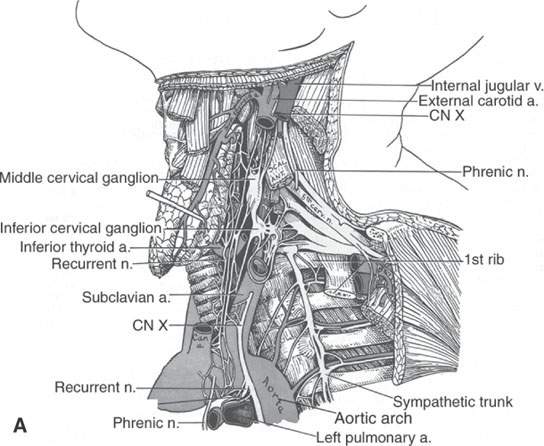
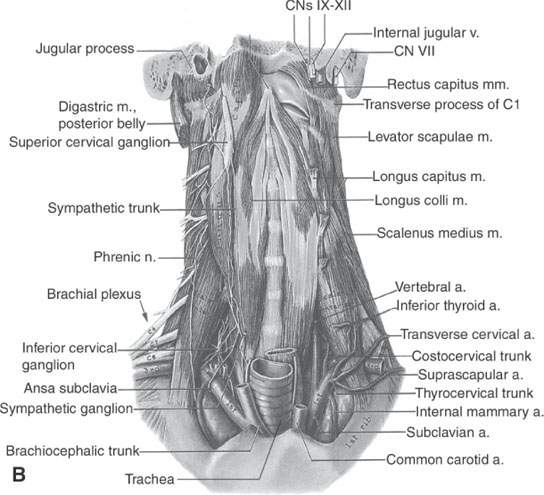
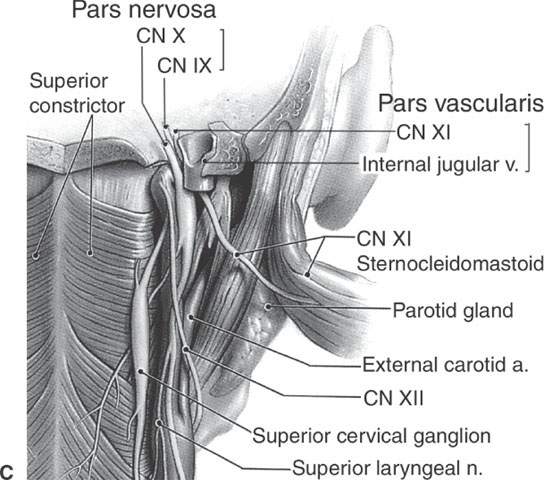
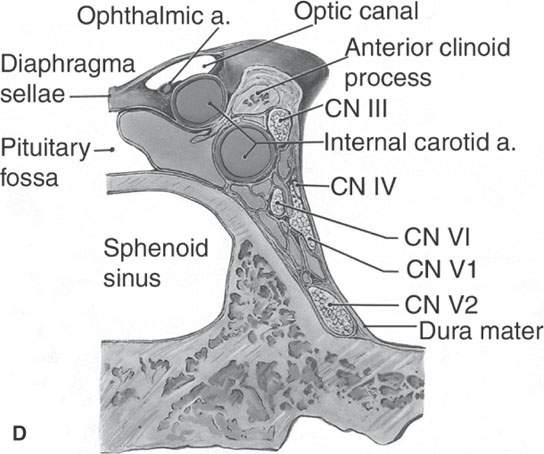
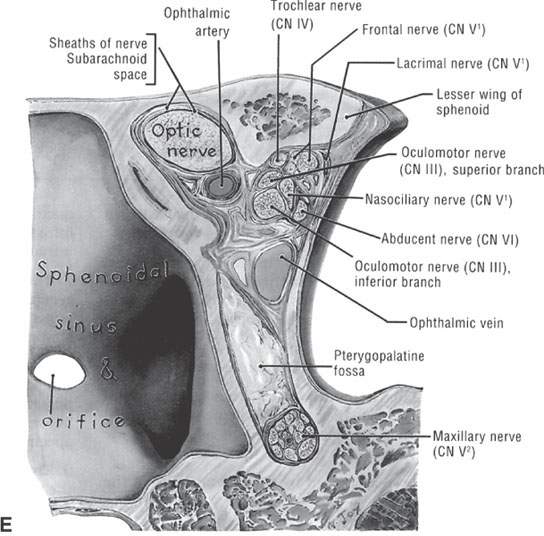
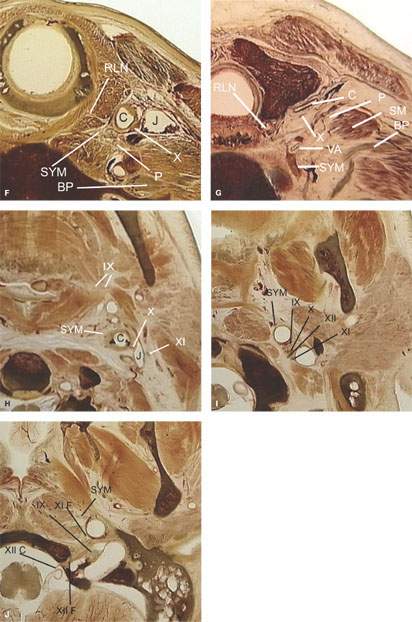
FIGURE 141.1. Anatomy of the cervical sympathetic plexus. A–E: Anatomic drawings of the pre- and postganglionic fibers of the cervical sympathetic plexus, illustrating their close relationship to cranial nerves (CNs) IX through XII (A–C). The sympathetic plexus coursing along the internal carotid artery enters the cavernous sinus and briefly travels along CN VI before joining the nasociliary nerve (branch of V3). The sympathetic fibers will innervate parts of the ear and orbit (D–F). F–J: Anatomic sections from the level of the inferior cervical ganglion to the base of the skull. (SYM, sympathetic plexus; RCN, recurrent laryngeal nerve; C, carotid artery; J, jugular vein; P, phrenic nerve; BP, brachial plexus; SM, anterior scalene muscle; VA, vertebral artery. CNs are indicated by roman numerals, and “C” designates the cisternal segment and “F” the foraminal segments of the respective CNs.)
Stay updated, free articles. Join our Telegram channel

Full access? Get Clinical Tree








